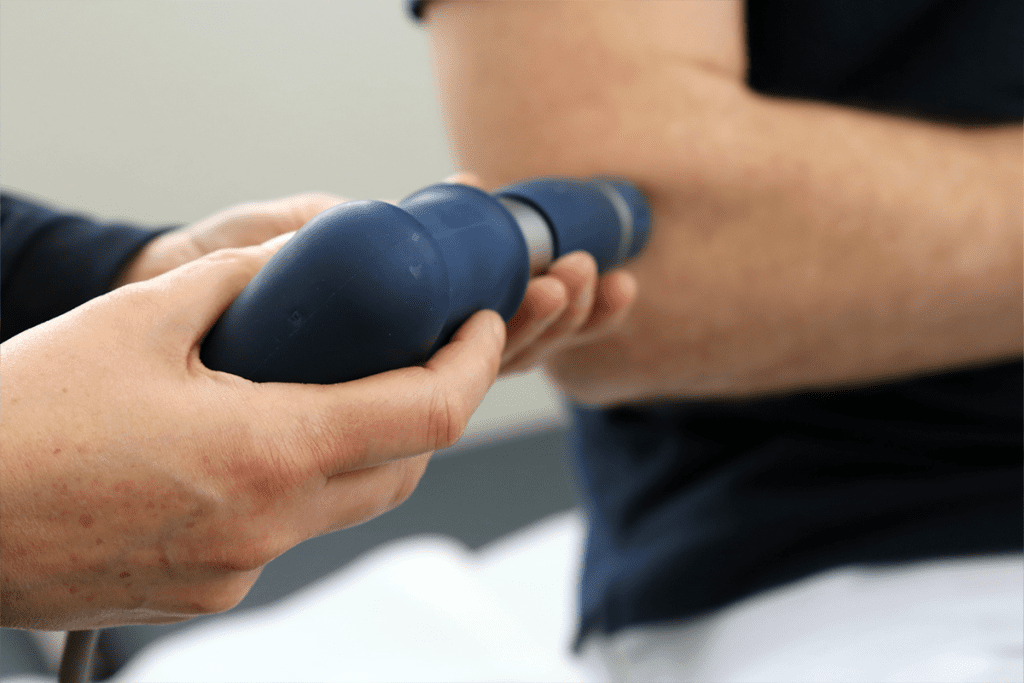Last Updated on November 25, 2025 by
We are seeing a big change in medicine with new, noninvasive ways to heal. Regenerative medicine is leading the way, giving patients safer and better ways to get well. Erectile dysfunction (ED) is a big problem, affecting millions of men. It can make life hard both physically and emotionally.

Focused shockwave therapy is getting more attention as a new treatment. But many people look for alternative treatments first. We’ll look at the newest non-invasive treatments, like PRP injections and stem cell therapies. They are showing great promise for treating ED and other issues.
In 2024, we’re seeing a big move towards treatments that don’t hurt and don’t need drugs. This change comes from patients wanting options that work well but have fewer side effects.
Shockwave therapy is used for many health issues, like erectile dysfunction and kidney stones. But, it’s not for everyone and not all patients get the same results.
“Shockwave therapy has helped many, but its limits have sparked interest in other treatments,” says a top urologist. Many healthcare experts are now looking into other choices.
More patients want treatments that don’t hurt and don’t use drugs. They’re worried about the side effects of traditional treatments. They want options that are safer and help them get better faster.
In 2024, over 25% of non-invasive treatments chosen by urologists and pain specialists are regenerative. This trend is likely to grow as more research supports these treatments.
Regenerative medicine, like PRP injections and stem cell therapies, is gaining popularity. These treatments show great promise for conditions like erectile dysfunction and muscle injuries.

Exploring shockwave therapy alternatives is key. Many are looking for non-invasive options and question shockwave therapy’s effectiveness. This search is driven by a desire for safer, more effective treatments.
Several alternatives to shockwave therapy have become popular. These include:
Each treatment has its own benefits and uses. For example, PRP injections have been effective in improving erectile function, sometimes better than shockwave therapy.

IIEF scores are important when comparing treatments for erectile dysfunction. Studies show PRP injections can greatly improve these scores, making them a strong alternative to shockwave therapy. This comparison helps patients and doctors choose the best treatment.
Liv Hospital leads in using new clinical protocols for shockwave therapy alternatives. They create personalized treatment plans using the latest in PRP injections and stem cell therapies. This approach aims to meet each patient’s specific needs effectively.
When looking at shockwave therapy alternatives, it’s important to consider the benefits and risks. Treatments like PRP injections and stem cell therapies show promise. But, it’s vital to understand their limitations and possible side effects to make an informed choice.
Regenerative medicine is a new field that offers non-invasive treatments like PRP injections and stem cell therapies. These methods use the body’s healing powers to fix damaged tissues.
PRP injections are getting more attention for their ability to heal tissues. They use a patient’s own blood to boost healing. This treatment is being tested for conditions like tendonitis and osteoarthritis.
Studies show PRP injections can help with pain and function in some musculoskeletal disorders. For example, a study on the National Center for Biotechnology Information website found PRP helps with knee osteoarthritis.
Stem cell therapies are another promising area in regenerative medicine. They use stem cells to fix or replace damaged tissues. These treatments are being looked at for many conditions, from injuries to degenerative diseases.
Stem cell treatments are a growing field. Early results are promising, showing they might help patients with hard-to-treat conditions.
PRP injections and stem cell therapies are being used in musculoskeletal and orthopedic fields. They offer non-surgical ways to treat chronic pain and injuries. These treatments can help avoid more invasive surgeries.
It’s important to consider the pros and cons of each treatment. A cost comparison between shockwave therapy and regenerative medicine treatments can help make decisions. While regenerative treatments might cost more upfront, they could save money in the long run by avoiding repeated surgeries.
Laser and ultrasound technologies are being looked at as effective treatments. They offer promising options for various medical conditions. This gives patients more choices for their care.
Laser lithotripsy is a top choice for treating kidney stones. It’s a safer option than traditional shockwave lithotripsy. This method uses a laser to break stones into smaller pieces that can pass easily.
Key benefits of laser lithotripsy include:
High-Intensity Focused Ultrasound (HIFU) is a growing alternative to shockwave therapy. It uses focused ultrasound waves to target specific areas. This non-invasive treatment can offer relief without surgery or medication.
The advantages of HIFU include:
Therapeutic ultrasound has been used for decades. It promotes healing and reduces inflammation. Healthcare providers use it to stimulate blood flow, reduce pain, and enhance healing.
Therapeutic benefits of ultrasound include:
Laser and ultrasound treatments are promising alternatives to shockwave therapy. They offer benefits for patients. Healthcare providers can make better decisions with this knowledge.
Shockwave therapy isn’t the only choice. Traditional treatments offer other ways to heal. When dealing with issues like kidney stones or erectile dysfunction, it’s important to consider the pros and cons of each option.
Physical therapy is a non-invasive, drug-free method. It can be very effective for some problems. For example, pelvic floor physical therapy can strengthen muscles and help with pelvic floor dysfunction. This approach is great because it avoids the risks of more invasive treatments.
Benefits of physical therapy include:
For some issues, medication might be a better choice than shockwave therapy. When deciding between medication vs shockwave for stone treatment, the stone’s size, location, and the patient’s health matter. Medications can help manage symptoms or help pass kidney stones, which is less invasive than shockwave therapy.
But, medications have their own downsides, like side effects and the need for ongoing care.
If shockwave therapy doesn’t work or isn’t right, surgical options instead of shockwave therapy might be considered. Surgery can offer a more lasting fix for issues like big kidney stones or complex urethral strictures.
Surgery comes with risks, but it’s chosen when the benefits are greater. It’s key for patients to talk about the possible complications and risks of alternatives to shockwave therapy with their doctor to make a well-informed choice.
When shockwave therapy doesn’t work, it’s time to look at the condition again and other treatment options. It’s important to check the diagnosis and think about other ways to treat the problem.
After shockwave therapy fails, we do a detailed check-up. This includes:
This careful check helps us figure out why the treatment didn’t work. It also helps us plan a new treatment.
When shockwave therapy doesn’t work, we look at other treatments. This might include:
We talk to our patients about these options. We explain the good and bad of each to find the best next step.
Sometimes, mixing treatments can help. We look at combining therapies, like:
Combining treatments can make a treatment plan more complete. It addresses different parts of the problem. We carefully think about the good and bad of mixing treatments for each patient.
By looking at reassessment, trying new treatments, and mixing therapies, we can find a good plan even if shockwave therapy doesn’t work.
When looking at treatment options, it’s key to compare the costs of shockwave therapy and other treatments. The price of shockwave therapy can change a lot based on who you see and where you are. This makes it important to look at all the details.
How much you pay out of pocket depends a lot on your insurance. We’ll look at how different insurances cover shockwave therapy and other treatments. This helps patients know what they might have to pay.
Key factors influencing insurance coverage include:
Looking at the long-term costs and benefits of shockwave therapy versus other treatments is vital. We’ll look at how these treatments might save money and improve your life in the long run.
A long-term cost-benefit analysis looks at:
For some, home remedies and lifestyle changes can be cheaper than shockwave therapy. We’ll talk about the good and bad of these options.
Home remedies might include:
By thinking about these points, patients and doctors can choose the best and most affordable treatment.
Understanding the alternatives to shockwave therapy helps patients make better choices. We’ve looked at non-invasive, drug-free options like regenerative medicine and laser therapies. These include traditional treatments too.
When looking at non shockwave treatments for kidney stones, it’s key to consider how well they work and their cost. Some treatments might cost more at first but offer lasting benefits and quicker recovery.
We suggest talking to healthcare experts to find the right treatment. This way, patients can make choices that lead to better health. Our aim is to support and guide, helping patients manage their health effectively.
Alternatives to shockwave therapy include laser lithotripsy, percutaneous nephrolithotomy, and ureteroscopy. These methods are effective for those not suited for shockwave therapy or who haven’t seen results.
Yes, non-invasive options include physical therapy, medication, and regenerative medicine like PRP injections and stem cell therapies.
PRP injections are effective for some conditions, sometimes better than shockwave therapy. But, results can vary based on the condition and patient.
Laser lithotripsy has higher success rates for large stones and fewer complications. It’s also good for stones not helped by shockwave therapy.
Yes, like any treatment, alternatives have risks and complications. These depend on the treatment and should be discussed with a healthcare provider.
Costs vary by treatment, location, and provider. Some alternatives might be pricier, while others could be more affordable.
Home remedies can help with symptoms but aren’t a full replacement for medical treatments like shockwave therapy. Always consult a healthcare provider before using them.
Coverage varies by treatment, insurance provider, and policy. Check with your insurance to see what’s covered.
Yes, combining shockwave therapy with other treatments like physical therapy or regenerative medicine can enhance results and improve outcomes.
Consider the condition, risks and benefits, and your needs and preferences. Always consult a healthcare provider to choose the best treatment.
Subscribe to our e-newsletter to stay informed about the latest innovations in the world of health and exclusive offers!